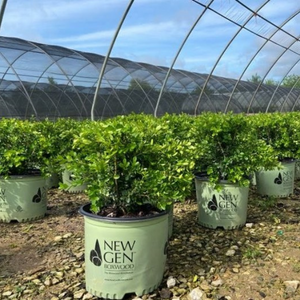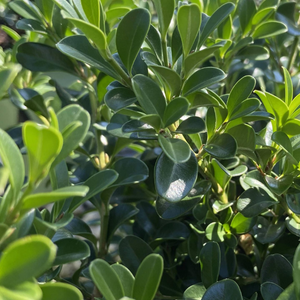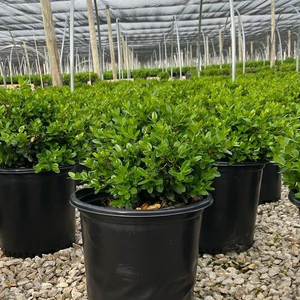For its numerous forms and distinctive foliage, Boxwood (Buxus L. spp., Buxaceae) is a staple in residential and commercial landscape projects. Among its many uses, these versatile and attractive woody shrubs define borders, anchor foundation plantings, provide privacy and screen utilities.
They’re in demand, too. At a market value of $126 million, more than 11 million boxwoods are sold annually in the United States, according to the Horticulture Research Institute (HRI), published in the Journal of Environmental Horticulture (2020). Pests, climate and weather are obvious risk elements that affect plant health and vitality, for boxwood, they also present a conundrum.
Protecting crops is a concentrated effort. Among the more serious impacts on cultivated and native Buxus species are boxwood blight and boxwood leafminer. With boxwood blight, the culprit is the contagious Calonectria henricotiae and C. pseudonaviculata fungus, which thrives in humid, warm conditions. Symptoms are rapid leaf drop, blackened stems and browning foliage. Boxwood leafminer is a destructive flying insect. Its larvae feed on tissue between the outer surfaces of the foliage, making leaves appear blistered.
Boxwood blight was first discovered in the United Kingdom in the mid-1990s and spread throughout the country in just six years before finding its way into continental Europe. It was found in Connecticut and North Carolina in 2011 and is confirmed in roughly 20 states and three Canadian provinces. Last year, USDA’s Animal and Plant Health Inspection Service prohibited exports and re-exports of boxwood from entering the United States from Canada.
To help prevent and control the spread of pests and disease, the HRI established a fund dedicated to boxwood blight research and created a working group with the National Plant Board. Among the outcomes is a Boxwood Blight Best Management Practices document designed for plant nurseries. The HRI also researched taxa to determine which cultivars are consistently most disease resistant across environments.
At Loma Vista Nursery, we are committed to growing healthy plants for independent garden centers, landscape contractors and wholesale distributors. Here are a few of the pest and disease resistant boxwood cultivars we grow.

NewGen® Freedom Boxwood (Buxus NewGen Freedom® ‘SB 300’ PP32421)
NewGen® Freedom Boxwood
This quick grower is a good substitute for Wintergreen Boxwood (Buxus sinica var. Insularis ‘Wintergreen’). It has good resistance to boxwood blight and boxwood leafminer. Deer resistant, NewGen® Freedom Boxwood grows between 3 and 6 inches annually and requires pruning in late winter or early spring. Apply a 1- to 2-inch layer of mulch to help keep soil moist, reduce weeds and provide weather protection.
NewGen® Freedom Boxwood matures to 3.5 feet tall and wide after 15 years and has a unique natural shape. This cultivar likes sun, part sun and shade. Plant in USDA Hardiness Zones 5 through 8.

NewGen Independence® (Buxus NewGen Independence®)
NewGen Independence® Boxwood
With all the features of a classic boxwood, NewGen Independence® performs well in leafminer trials and has good resistance to boxwood blight. Plus, it is deer resistant. Showy leaves are slightly elongated on a strong branching structure. Rich green foliage stays true to its color through fall and winter.
NewGen Independence Boxwood has a mounded habit that is nearly as tall as it is wide. It has a medium growth rate of 2 to 4 inches per year. Mature height and width at 15 years is 3 feet. It likes sun, part sun and shade. Plant in USDA Hardiness Zones 5 to 8.

Buxus ‘Little Missy’ (Buxus microphylla ‘Little Missy’ PP 24,703)
Buxus ‘Little Missy’
This is one tough boxwood! Buxus ‘Little Missy’ consistently ranked high in resistance to boxwood blight during a 2020 USDA analysis. This stylish shrub gets its name from its round, dense habit. Compact, Buxus ‘Little Missy’ is about 2 feet high and wide at maturity.
Buxus ‘Little Missy’ has glossy, dark-green foliage. It can stand alone in a small landscape or provide structure in plant groupings. It requires full sun and regular watering until established. Plant in USDA Hardiness Zones 5 through 9.
Learn More About Landscape Plants from Loma Vista Nursery
Loma Vista Nursery’s staff members are experts in the field. We love helping people learn and understand more about healthy plants that perform well in Midwest landscapes. For more information, visit our plant catalog. Feel free to email us at sales@lomavistanursery.com or call us at (785) 229-7200 to get answers to your plant-related questions.
Connect With Us
Stay up to date on our plant recommendations, growing tips and more by following us on social media.
